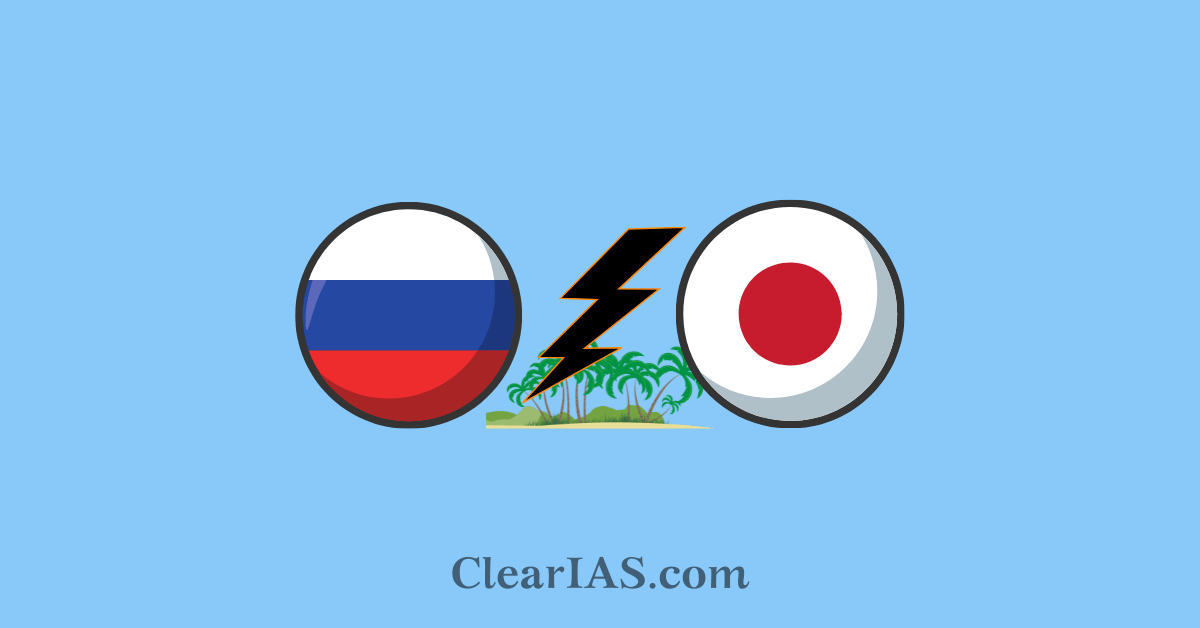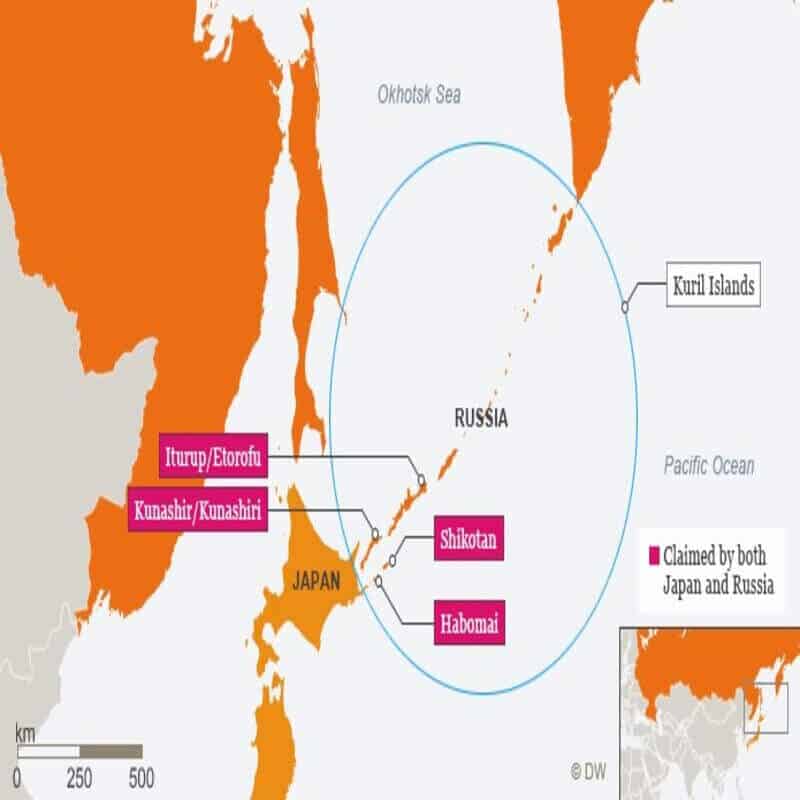
Kuril Islands dispute is a territorial dispute between Japan and Russia over a chain of islands in the North Pacific Ocean. Read here to know more about the dispute.
Japan described four islands whose ownership it disputes with Russia as illegally occupied in the latest version of a diplomatic Bluebook (Diplomatic bluebook of Japan is an annual report on Japan’s foreign policy and international diplomacy published since 1957).
- The use of stronger language highlighted the strained relations between the two sides amid the Russian invasion of Ukraine.
Russia refers to these islands as the Kuril Islands, whereas Japan calls them part of their Northern territories.
Japan is also having a similar dispute regarding Northern territories with South Korea. South Korea refers to the islands as Dokdo islands.
The geographic location of the Kuril Islands

The Kuril Islands are a chain of islands stretching from the Japanese island of Hokkaido to the southern tip of Russia’s Kamchatka Peninsula.
The islands separate the Okhotsk Sea from the North Pacific Ocean.
It consists of 56 islands and minor rocks. The dispute is concerning four islands.
The islands are part of the Ring of Fire belt of geologic instability circling the Pacific.
- It contains at least 100 volcanoes, of which 35 are still active, and many hot springs.
- Earthquakes and tidal waves are common phenomena over these islands.
History of Kuril Islands Dispute
The Kuril island chain was annexed by the soviet union during the Kuril island landing operation at the end of World War II.
The Kuril Islands dispute between Japan and Russia is over the sovereignty of the South Kuril Islands.
The islands in dispute are:
- Iturup or Etorofu Island
- Kunashir or Kunashiri Island
- Shikotan Island
- Habomai Island
These islands are known as Southern Kurils by Russia whereas Japan calls them the Northern Territories.
The Kurils were originally inhabited by the Ainu people. Later after several explorations in the 17th and 18th centuries, they were later settled by the Russians and Japanese.
- The Ainu are the indigenous people of the lands surrounding the Sea of Okhotsk, including Hokkaido Island, Northeast Honshu Island, Sakhalin Island, the Kuril Islands, and the Kamchatka Peninsula and Khabarovsk Krai, before the arrival of the Yamato Japanese and Russians.
- The Ainu or the Aynu, also known as the Ezo in the historical Japanese texts.
- After the annexation of the Hokkaido islands by Japan, the Ainu have all but nearly assimilated into Japanese culture.
Agreements between Japan and Russia over the Kuril Islands
The first Russo-Japanese agreement to deal with the status of Sakhalin and the Kuril Islands was the 1855 Treaty of Shimoda, which first established official relations between Russia and Japan.
Treaty of Shimoda (1855):
In 1855, Japan and Russia concluded the Treaty of Shimoda, which gave control of the four southernmost islands to Japan and the remainder of the chain to Russia.
Treaty of Saint Petersburg (1875):
In the Treaty of Saint Petersburg, signed between the two countries in 1875, Russia ceded possession of the Kurils to Japan in exchange for uncontested control of Sakhalin Island.
The Russo-Japanese War of 1904–5 was a military disaster for Russia. The 1905 Treaty of Portsmouth, which concluded at the end of this war, gave the southern half of Sakhalin Island to Japan.
During World War II Japan was an ally of Germany and USSR had an understanding of it. But later on, Soviet and Japanese soldiers were on opposite sides.
Yalta Agreement (1945):
In 1945, as part of the Yalta agreements (formalized in the 1951 Treaty of Peace with Japan), the islands were ceded to the Soviet Union, and the Japanese population was repatriated and replaced by the Soviets.
San Francisco Peace Treaty, 1951
This treaty was signed between the Allies and Japan in 1951 and stated that Japan must give up all right, title, and claim to the Kuril Islands, but it also does not recognize the Soviet Union’s sovereignty over them.
The above two treaties after World war complicated the issues further leading to modern-day disputes over the Kuril Islands.
Japan-Soviet Joint Declaration (1956):
In 1956, diplomatic ties were restored between Japan and Russia by Japan-Soviet Joint Declaration.
During the 1956 peace talks between Japan and the Soviet Union, the Soviet side proposed to settle the dispute by returning Shikotan and Habomai to Japan.
Japan agreed to this and the declaration ended the state of war between the two countries. But the Kuril Islands dispute persisted in the form of interpretation of territorial provisions.
Latest developments:
Despite a series of agreements, the dispute continues and Japan still claims historical rights to the southernmost islands and has tried repeatedly to persuade the Soviet Union and, from 1991, Russia to return those islands to Japanese sovereignty.
In 2018, the Russian President and the Japanese Prime Minister met on the sidelines of the East Asia Summit and decided to end the territorial dispute with the Japanese PM agreeing to negotiate based on the 1956 declaration.
This showed that Japan has given up the two islands to maintain peace with Russia.
However, Russia indicated that the joint declaration signed by Japan and the Soviet Union in 1956 neither mentions a basis for returning Habomai and Shikotan nor clarifies which country has sovereignty over the islands.
In 2019, the Japanese PM made it clear that the country is not in the favour of withdrawing control over the Islands. Japan also believes that the islands are an inherent part of the nation’s territory, therefore, it aims to sign the peace treaty after the territorial issue is resolved.
Importance of Kuril Islands
Why are the Kuril Islands been contested so aggressively by two developed nations? The major reason is resources.
Natural resources:
- The islands are surrounded by rich fishing grounds and are thought to have offshore reserves of oil and gas.
- Also, rare rhenium deposits have been found on the Kudriavy volcano on Iturup.
- Nickel-based superalloys of rhenium are used in the combustion chambers, turbine blades, and exhaust nozzles of jet engines.
Tourism:
Tourism is also a potential source of huge income, as the islands have several volcanoes and a variety of birdlife that can be utilized for adventure activities.
Strategic Importance:
In 2020, Russia deployed missile systems in the region and also plans a submarine project, and intends to prevent any American military use of the islands.
Cultural Importance:
The Japanese people, especially conservatives in Hokkaido, are emotionally attached to the islands.
Global stand on the Kuril Island dispute
The European Parliament 2005 called on Russia to return to Japan to the occupied south Kuril Islands.
The United States recognizes Japan’s sovereignty over the islands.
China has gone back and forth on the issue depending on its relation with Russia.
The South Korean government has mostly kept a neutral stance over the Russia-Japan dispute as it also has claims over what it calls Dokdo Islands. South Korea and Japan are in a diplomatic dispute over this for more than 300 years.
Way forward
The interest of both countries cannot be satisfied fully in any agreement on this issue but a midway has to be devised.
The militarization of the islands by Russia is considered to be its strategy to strengthen its position in the pacific via the North Sea route which worries Japan.
The interests of the Ainu people should also be taken into account as they are the native inhabitants of the islands.
The resolution of the dispute is important or else it will add to the already unstable indo-pacific region.






Russian war in Ukraine appears to be infusing new life energy to a low key dispute of Kuril Islands between Japan and Russia.
(a). It is 22 April 2022 when Japan brings out its yearly report through Japan’s Diplomatic Bluebook 2022, highlighting its claim dominantly over a set of four islands known as Kuril Islands. A bit of historical background of these set of islands in dispute may be mentioned here. The islands were owned and occupied by Japan before Japan surrendered in 1945 on defeat of German camp in Second World War. But Japan’s surrender in 1945, is said to have led to the seizure of the islands by the Soviet Union. After the surrender, Japan has not yet signed peace treaty with the Soviet Union/Russia on the ground that dispute over the Kuril Islands is yet to be resolved. Japan has been raising the issue with the Soviet Union/Russia when different solutions have emerged for firming up. At one stage of time, the solution emerged for consideration was that Japan would be returned two of the four islands. But this was not given a final shape. At another stage of time, solution emerging was a cooperative development of the Islands for business and energy. It is gathered from news media that Kuril Island has a fund of commercial fishing and marine wealth, besides potential of energy resource like wind power.
(b). According to some analysts, Russia’s war in Ukraine has contributed to the elevation of Japan’s claim over Kuril Islands. Now, through the yearly Diplomatic Bluebook 2022, Japan is reported to have said that these islands are under “illegal occupation” of Russia. While the tone of claim was softer during several past decades, it is now markedly stronger and whole-covering. “ The northern territories are islands over which Japan has sovereignty, and are inherent part of the territory of Japan, but now are illegally occupied by Russia”, the bluebook reported to have said.
©. In the context of new development in the claim of Kuril Islands, it may be apt to refresh readers with this Vedic astrology writer’s related prediction in paragraph 3 of article -“ Reading the year 2022 astrologically for Japan” – published at http://www.medium.com/@kushal1948 last year 2021 on 1 September.
(d). Paragraph 3 in article published on 1 September 2021, referred to in preceding paragraph, reads as follows:-
“(3). Some changes in the Constitution or law to give well-intended and meaningful shape to long-cherished aspirations of people appear to be coming up during April and after in year 2022. These can take a concrete shape around middle or end of the year. It appears the changes in Constitution or law may cover Judiciary as well for still better defining their role, functions, powers and accountability. This planetary configuration may also imply some endeavors in Japan to settle some political or territorial issues having something to do with energy resources, climate change or promotion of peace philosophy.”
(e). Here, paragraph 3 may need some implied interpretation. The objective of any constitution or law is to regulate matters in a nation, such regulation is conditioned by intent of justice. So, prediction in para 3 would correspond to a change or elevation in stance of Japan for doing justice, so as to give well-intended and meaningful shape to long-cherished aspirations of people during April and after in year 2022. Further, the indication may be found clothed in unambiguous words -“ This planetary configuration may also imply some endeavors in Japan to settle some political or territorial issues having something to do with energy or climate change or peace philosophy”. So indication clearly implies and is relatable to Kuril Islands.
(f). The details brought out here may suggest that the prediction made nearly eight (8) months prior on 1 September 2021, has been confirmed by actual happenings on the ground.
(g). The predictive article published on 1 September 2021 can be reached via https://medium.com/@kushal1948/reading-the-year-2022-astrologically-for-japan-691410e96046
Kushal kumar,
Panchkula-India.